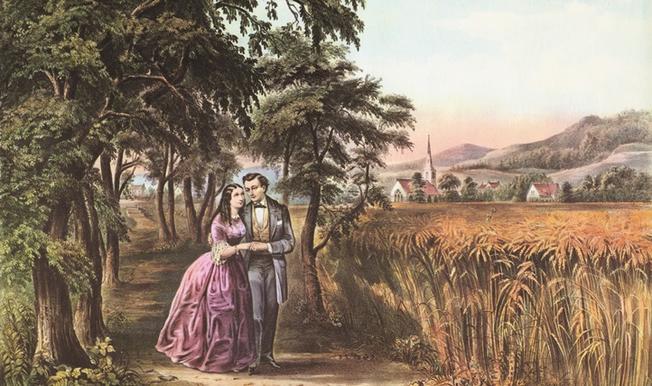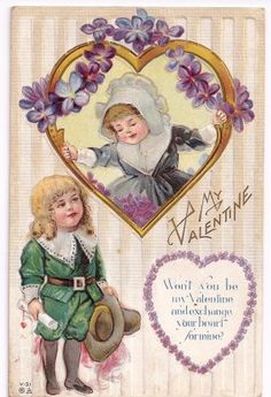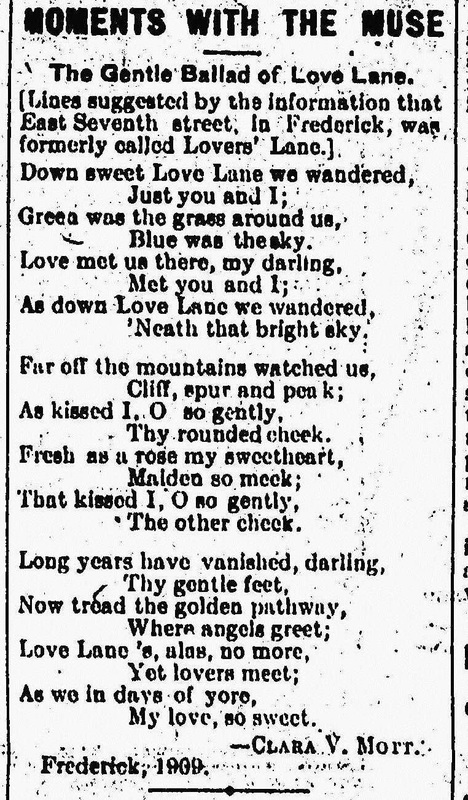HSP HISTORY Blog |
Interesting Frederick, Maryland tidbits and musings .
|
 Artistic depiction of ancient Lupercalia festival. Artistic depiction of ancient Lupercalia festival. Well, we have officially navigated past Super Bowl Sunday, and it’s time once again for another fabricated, commercial-based, “pseudo holiday.” Welcome to Valentine’s Day! As opposed to the Super Bowl, Valentine’s Day certainly requires a bit more creative thought and, at times, stealth planning by participants in advance. Luckily, living here in a place like Frederick County, Maryland offers the opportunity to easily garner tangible members of the 4 major Valentine food groups: 1.) jewelry 2.) chocolate/candy 3.) flowers 4.) clothing/lingerie (of any rating) Interestingly, gifts are merely an invention of the last century, adding a new degree of stress and pressure. Now 2,000 years ago, the yearly occurrence that grew into today’s Valentine’s Day required a simpler effort by everyone involved. In ancient Rome, during the month of February, a fertility-themed feast called Lupercalia was held in honor of the wolf-god Faunus, a Roman knockoff of the rustic Greek god Pan. The names of young females were secretly placed in a box and shaken up. The young men drew a name and, voila, each obtained what we would equate to be his valentine. Five-hundred years later, the leaders of the early Christian church “muscled in,” wanting to rid the empire of pagan ritual and superstition. Males now had to draw the name of a saint, instead of that of a young maiden, and were expected to imitate the example of said saint’s life with emphasis on sacrifice and humility. The ladies then pursued the “holy portrayer” that attracted them most.  Geoffrey Chaucer (1343-1400), "the Father of English Literature." Geoffrey Chaucer (1343-1400), "the Father of English Literature." So where does St. Valentine come into play? And how is he associated with love? Well, it’s a long story, but the namesake got his initial start as being one of the many saints imitated. Actually, there were several martyred Valentine’s over the years, so his name came up often! This lasted throughout the balance of the Middle Ages, and St. Valentine was still not the love-wielding “go to guy” we know him as today. This would come centuries later as many scholars give the credit to Geoffrey Chaucer (1343-1400), he of Canterbury Tales fame. The first recorded association of St. Valentine, Valentine's Day and romantic love can be found within Chaucer’s poem Parlement of Foules (1382) in which he wrote: “For this was on seynt Volantynys day Whan euery bryd comyth there to chese his make.” I’m guessing you may have just experienced a cruel flashback to high school sophomore year English class. So I will gladly assist with the translation: "For this was on St. Valentine's Day, when every bird cometh there to choose his mate." This is some sweet prose, and surprisingly from the same guy who gave us our first educational foray into flatulence humor with the Miller’s Tale. Not only did Chaucer’s line above build a context between Valentine’s Day and romance, it also gave rise to the expression of “love-birds” and thus, the euphemism involving “the birds and the bees.” St. Valentine quickly became the “poster-saint’” for amour and affection, and this would directly create a greeting card industry—of course with much deserved props also going to Johannes Gutenberg as well. I journeyed back in Frederick’s past to see what the local newspapers were saying about Valentine’s Day. In the latter 19th century, I found that it was a time in which the Valentine card itself was the central focus. Some were ornate, made of fancy ribbon and lace. Others were die cut. Many ornate cards were imported from Europe. Several businesses of town carried Valentine’s cards and I assumed that this was a profitable occasion for newspaper owners as well since they had printing means to be purveyors of cards themselves, and collected increased advertising from merchants and event organizers marketing Valentine-oriented wares and activities. I was quickly taken aback, however, by the tone used by the writer of an article in the February 7, 1887 edition of the Frederick (MD) Daily News:  1854 Sachse & Co. lithograph View of Frederick looking north from East Church St. and showing the northeastern boundary of the city. 1854 Sachse & Co. lithograph View of Frederick looking north from East Church St. and showing the northeastern boundary of the city. Today, Frederick offers so many opportunities to truly experience and enjoy the Valentine occasion with significant others. A plethora of restaurants can host the traditional Valentine’s dinner. Varied entertainment venues and amusements can be enjoyed. In addition, we also have plenty of historic churches to choose from for those desiring an “old-school” experience (to study up on saints and saintly behavior.) And with the current exception of a downtown hotel and conference center, there are plenty of lodging choices (some romantic, and others simply functional) for out of town visitors. In flipping through antiquated newspapers of the early 20th century, I stumbled upon a few opportunities afforded our ancestors “back in the day,” but not available to young (and old) sweethearts in Frederick at present. One of these included the forgotten address of Frederick City's most romantic spot— Love Lane. Love Lane was a moniker given to Frederick’s East Street, and seemed to be in fashion during much of the 1800’s. I have seen it used going back to 1822, five years after the city was first incorporated. At the time, this dusty path was the eastern boundary of town, and ran between today’s South and 7th streets. The opposite of bustling Market Street, Love Lane featured beautiful vistas of rolling hills and farmland to the east, and small homes, quaint street corners, and the eventual St. John’s Cemetery, all with a splendid backdrop provided by Catoctin Mountain to the west. Beautiful sunsets and feelings of serenity must have been welcome escapes for city dwellers of all ages. A reconvening with nature here was the second best whimsical destination that Frederick could offer—the first being Mount Olivet Cemetery (opened in 1854) and located a good hike south of town. However, the latter garden-cemetery was not the ideal romantic location for a young couple’s dreamy first date or a budding relationship. All good things must come to an end, and that was the case with Love Lane. The post-Civil War period brought the Pennsylvania Railroad right down Love Lane, eventually setting the stage for industry to locate sidings adjacent its right of way. Lumberyards, foundries, the gas works and brick plants sprouted up. At least a tannery on Carroll Creek in this vicinity was owned by the fittingly named Valentine Byerly. Some couples simply ignored the progress and remained “young at heart, regardless of intrusions.” One such was Clara V. Mott who wrote a poem about Love Lane in 1909. A regular contributor to the Frederick Daily News, Mrs. Mott was known for her Moments With the Muse column. She was also a resident of East 7th Street, and on one occasion took to reminiscing about a happier time. She wrote this piece a year after the passing of her husband Albert, a former Union Civil War veteran. A century of growth has drastically changed the once paradisiacal route. Starstruck couples walked elsewhere. The memory of Love Lane would further fade with the opening of Baker Park in the late 1920’s, and a number of charming neighborhoods that soon surrounded it. Meanwhile, the early industries gave rise to 20th century giants like Frederick Iron and Steel, the Economy Silo Factory, Ox Fibre Brush and the Everedy Company. And who can forget the “loveable” Reliable Junk Company? A jaunt with one’s steady gal adjacent Shab Row and Everedy Square is far better today than it was fifty years ago. But I think it’s still a stretch to find romance while walking “hand in hand” a few blocks further north through the current assemblage of auto repair establishments, a power transformer sub-station, junk yards, 7-11, plumbing repair warehouses, etc. There is a reason why it’s back to being called East Street, and not Love Lane anymore! At least on the north-end extension (of this storied thoroughfare), recent generations of lovers could find “heartwarming delights” at the old Freeze King, while new generations can fill the latter’s void with the Family Meal Restaurant . Most importantly, love on the old lane can still be found in the form of Love and Company, a local firm that specializes in senior living marketing, for what it’s worth. Another Lovers Lane once existed in Frederick County, and I will tell you all about it in next week's edition of the HSP "Hump Day History" Blog entitled: Frederick and Valentine’s Day—Part 2: A hunk of “Burning” Love.
0 Comments
Leave a Reply. |
AuthorChris Haugh Archives
February 2024
Categories |
Proudly powered by Weebly








 RSS Feed
RSS Feed